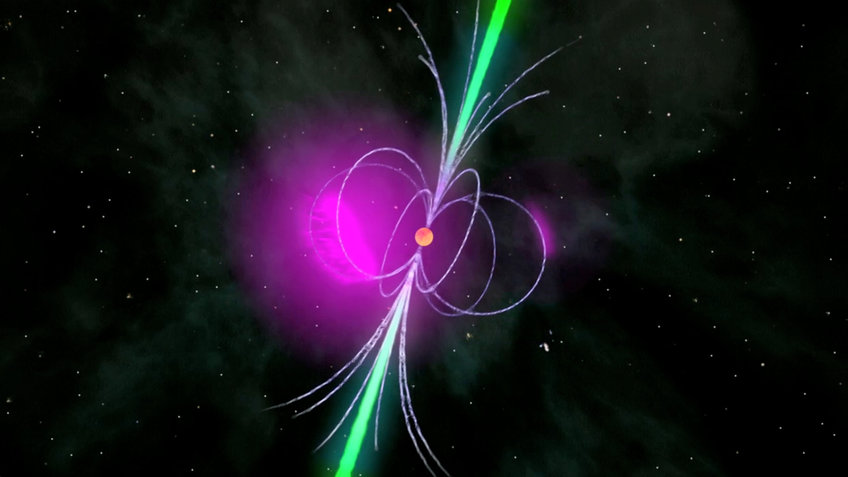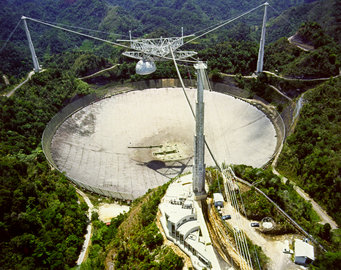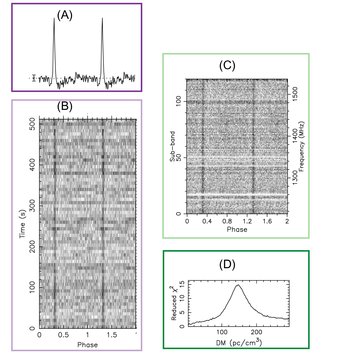With Einstein@Home and Zooniverse, citizens can identify previously unknown pulsars from home
When large radio telescopes look for the regular blinking of neutron stars, which rotate very quickly around their own axis like cosmic lighthouses, these telescopes initially collect large amounts of data that need to be sifted through. The signals from such pulsars, which would help us to better understand fundamental physics, are all too well hidden in the data and analysing them is very computationally intensive. Citizens can now help to search for such hidden signals even better from home.

Cosmic lighthouse: A radio pulsar is a compact neutron star that accelerates charged particles to relativistic speeds in its extremely strong magnetic field. Radio waves (green) are emitted in a cone shape above the magnetic poles. The rotation swivels the radio light cones across the line of sight of the radio telescope, causing the pulsar to light up periodically in the data.
© NASA/Fermi/Cruz de Wilde
In brief: Since 2009, Einstein@Home volunteers have helped analyze observations from the large Arecibo telescope’s PALFA pulsar survey. The project’s science team has sifted through the results to find tens of thousands of promising pulsar candidates and produced a small set of diagnostic plots for each. Now, the new “Pulsar Seekers” project is calling on volunteers from the Zooniverse citizen science platform to sort through these plots to find new pulsars.
Distributed computing augmented by distributed thinking
Since its launch in 2005, the Einstein@Home project has been searching for and finding new neutron stars and compact remnants of exploded massive stars by incorporating the judgement of volunteers and their home computing capacities. The Max Planck Institute for Gravitational Physics (Albert Einstein Institute) in Hanover and the University of Wisconsin-Milwaukee are running the project. “Getting volunteers more directly involved in Einstein@Home and having them view and actively classify pulsar candidates has been our plan for a long time. It’s great to see this become a reality with this new Zooniverse project,” says Bruce Allen, director of Einstein@Home and director at the Max Planck Institute for Gravitational Physics (Albert Einstein Institute, AEI) in Hannover, Germany. Einstein@Home pools the otherwise unused computing power on the PCs of more than 15,000 volunteers, making it one of the largest projects of its kind in the world. Since 2009, Einstein@Home has analysed data from the Arecibo radio telescope and found 31 new radio pulsars, a special type of neutron star. Einstein@Home is now working together with Zooniverse. On this successful web portal for citizen science, volunteers can classify graphical representations of the Einstein@Home results in order to discover further pulsars in the Arecibo data.
Neutron stars are compact remnants of supernova explosions and consist of extremely dense matter. They are about 25 kilometers across and weigh more than our Sun. Because of their strong magnetic fields and fast rotation, they emit beams of radio waves like a cosmic lighthouse. When these beams point toward Earth during the neutron star’s rotation, it becomes visible as a radio pulsar. Pulsars are excellent astrophysical tools that enable research in several areas of astronomy, such as testing Einstein’s theory of general relativity, understanding the behavior of extremely dense matter, studying the thin gas between stars and our Galaxy’s magnetic field, and for searching low-frequency gravitational waves.
To date, Einstein@Home has discovered 31 radio pulsars in data from the Arecibo telescope, 24 radio pulsars in data from Parkes Observatory in Australia, and 39 gamma-ray emitting pulsars in data from NASA’s Fermi Gamma-ray Space Observatory. The project’s long-term goal is the detection of continuous gravitational waves from neutron stars that have yet to be observed.
Hunting for treasures in Arecibo’s legacy

The Pulsar Seekers Zooniverse project analyzes data from the Arecibo radio telescope, shown here in aerial picture before its 2020 collapse.
© NAIC – Arecibo Observatory
To search for new radio pulsars, telescopes like the iconic Arecibo radio telescope, which sadly collapsed in December 2020, observe hundreds of thousands of points in the sky, each for a few minutes. Each of these observations must then be checked for the regular pulsations expected from radio pulsars. Searches for pulsars alone in space can be done in a short time on a small number of computers. The search for pulsars in close orbits is much more computationally intensive, but worthwhile. If researchers could measure two neutron stars orbiting each other with orbital periods of just a few minutes, they would be able to subject the general theory of relativity to the most accurate tests yet.
Thanks to the Einstein@Home volunteers and the computing power they donate to the project, such searches become feasible. When the volunteers’ computers are finished analyzing an Arecibo observation, the end result of their combined efforts is a long list of nearly 400,000 candidates, or possible pulsar signals, each characterized by a handful of numbers. Typically, no more than one true pulsar is expected in an observation.
Separating the wheat from the chaff

For each pulsar candidate, Zooniverse volunteers will look at a set of four plots like the one shown here. A short tutorial will teach them how to distinguish a pulsar (as in this example) from terrestrial disturbances or random noise.
© Project “Pulsar Seekers”
“Einstein@Home has analyzed more than 150,000 observations made by the Arecibo radio telescope,” says Alexandra Botnariuc from the Max Planck Institute for Gravitational Physics. “This gives us the gigantic number of 60 billion pulsar candidates! This is far too many to look at each one individually, and most of them aren’t real astrophysical signals anyway”. She developed and implemented an algorithm to reduce this number by detecting similar candidates that are likely caused by the same astrophysical signal, and by identifying the most pulsar-like among them.
To get the ball rolling, the research team prepared diagnostic plots for the 50,000 most promising Einstein@Home pulsar candidates and set up a new Zooniverse project called “Pulsar Seekers”. “The number of candidates is so large that it is impractical for one person to do the job. This makes the collective human effort of Zooniverse participants invaluable in identifying true pulsar candidates,” says Rahul Sengar, a postdoctoral researcher at the University of Wisconsin-Milwaukee who is leading the Pulsar Seekers project. “We can’t wait to see what Zooniverse citizen scientists discover in our data!”
Citizen scientists will receive a short and simple tutorial on Zooniverse to teach them how to tell real pulsars from noise. “If all goes well, and several thousand Zooniverse volunteers participate in ‘Pulsar Seekers’, they will be able to sort through our first 50,000 pulsar candidates, separate the wheat from the chaff, and maybe find some exciting new pulsars, in just a few days,” says Colin Clark from the Max Planck Institute for Gravitational Physics.
BK/TB








